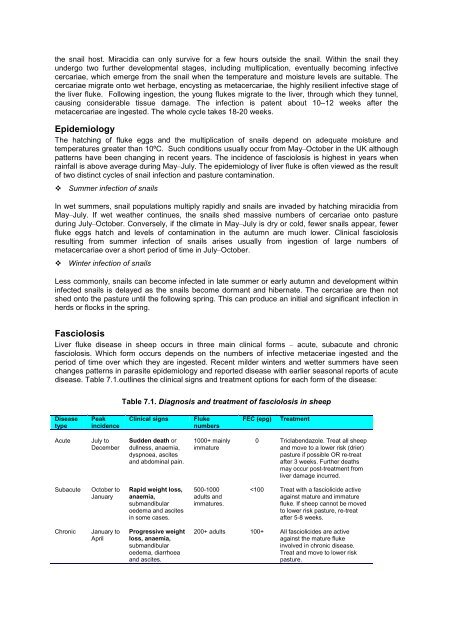Liver Fluke Fact Sheet - SCOPS
Liver Fluke Fact Sheet - SCOPS
Liver Fluke Fact Sheet - SCOPS
Create successful ePaper yourself
Turn your PDF publications into a flip-book with our unique Google optimized e-Paper software.
the snail host. Miracidia can only survive for a few hours outside the snail. Within the snail they<br />
undergo two further developmental stages, including multiplication, eventually becoming infective<br />
cercariae, which emerge from the snail when the temperature and moisture levels are suitable. The<br />
cercariae migrate onto wet herbage, encysting as metacercariae, the highly resilient infective stage of<br />
the liver fluke. Following ingestion, the young flukes migrate to the liver, through which they tunnel,<br />
causing considerable tissue damage. The infection is patent about 10–12 weeks after the<br />
metacercariae are ingested. The whole cycle takes 18-20 weeks.<br />
Epidemiology<br />
The hatching of fluke eggs and the multiplication of snails depend on adequate moisture and<br />
temperatures greater than 10ºC. Such conditions usually occur from May–October in the UK although<br />
patterns have been changing in recent years. The incidence of fasciolosis is highest in years when<br />
rainfall is above average during May–July. The epidemiology of liver fluke is often viewed as the result<br />
of two distinct cycles of snail infection and pasture contamination.<br />
� Summer infection of snails<br />
In wet summers, snail populations multiply rapidly and snails are invaded by hatching miracidia from<br />
May–July. If wet weather continues, the snails shed massive numbers of cercariae onto pasture<br />
during July–October. Conversely, if the climate in May–July is dry or cold, fewer snails appear, fewer<br />
fluke eggs hatch and levels of contamination in the autumn are much lower. Clinical fasciolosis<br />
resulting from summer infection of snails arises usually from ingestion of large numbers of<br />
metacercariae over a short period of time in July–October.<br />
� Winter infection of snails<br />
Less commonly, snails can become infected in late summer or early autumn and development within<br />
infected snails is delayed as the snails become dormant and hibernate. The cercariae are then not<br />
shed onto the pasture until the following spring. This can produce an initial and significant infection in<br />
herds or flocks in the spring.<br />
Fasciolosis<br />
<strong>Liver</strong> fluke disease in sheep occurs in three main clinical forms – acute, subacute and chronic<br />
fasciolosis. Which form occurs depends on the numbers of infective metaceriae ingested and the<br />
period of time over which they are ingested. Recent milder winters and wetter summers have seen<br />
changes patterns in parasite epidemiology and reported disease with earlier seasonal reports of acute<br />
disease. Table 7.1.outlines the clinical signs and treatment options for each form of the disease:<br />
Disease<br />
type<br />
Peak<br />
incidence<br />
Acute July to<br />
December<br />
Subacute October to<br />
January<br />
Chronic January to<br />
April<br />
Table 7.1. Diagnosis and treatment of fasciolosis in sheep<br />
Clinical signs <strong>Fluke</strong><br />
numbers<br />
Sudden death or<br />
dullness, anaemia,<br />
dyspnoea, ascites<br />
and abdominal pain.<br />
Rapid weight loss,<br />
anaemia,<br />
submandibular<br />
oedema and ascites<br />
in some cases.<br />
Progressive weight<br />
loss, anaemia,<br />
submandibular<br />
oedema, diarrhoea<br />
and ascites.<br />
1000+ mainly<br />
immature<br />
500-1000<br />
adults and<br />
immatures.<br />
FEC (epg) Treatment<br />
0 Triclabendazole. Treat all sheep<br />
and move to a lower risk (drier)<br />
pasture if possible OR re-treat<br />
after 3 weeks. Further deaths<br />
may occur post-treatment from<br />
liver damage incurred.<br />


